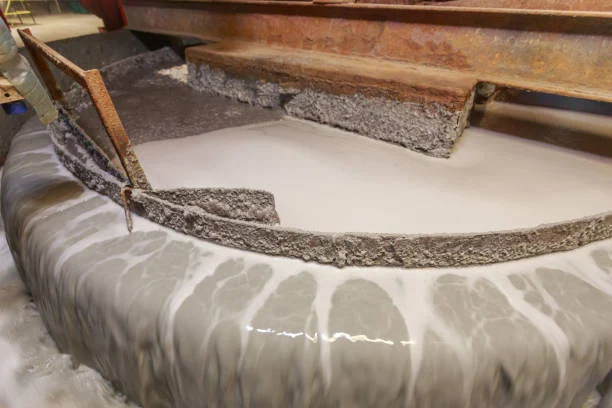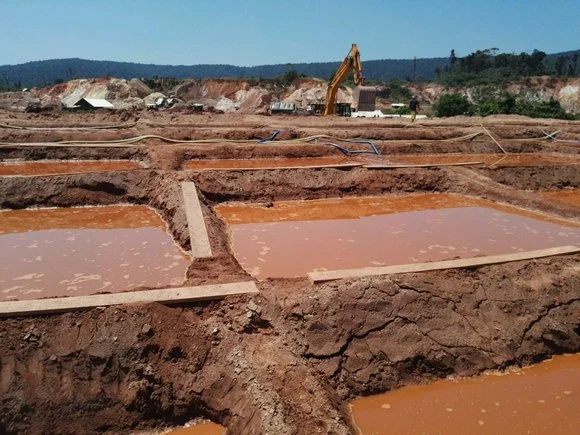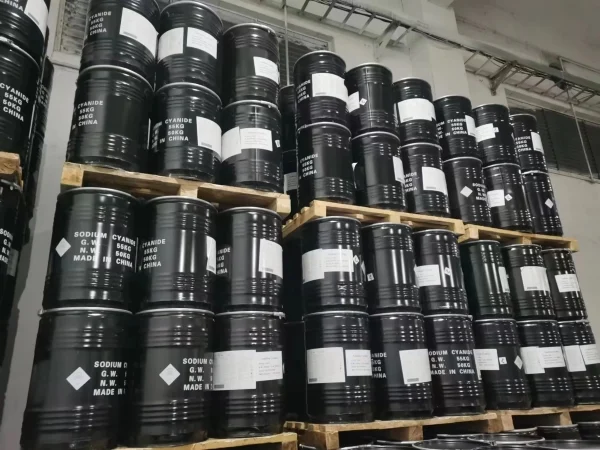
1. Introduction
In the field of mineral processing, the separation of lead and zinc minerals holds great significance. Froth flotation is a commonly employed method for this separation, and the use of suitable depressants is essential for achieving efficient separation. Sodium cyanide has long been widely used as a depressant in lead-zinc separation flotation. Understanding its inhibition mechanism is vital for optimizing the flotation process, enhancing separation efficiency, and reducing reagent consumption. This article aims to conduct a systematic study on the inhibition mechanism of Sodium cyanide in lead-zinc separation flotation.
2. Role of Depressants in Flotation
In the foam flotation process, depressants are reagents that can prevent or reduce the adsorption or action of collectors on the surface of non-target minerals and form a hydrophilic film on these mineral surfaces. In lead-zinc separation flotation, the primary objective is to separate lead minerals (such as galena) from zinc minerals (such as sphalerite). Without effective depressants, it is challenging to achieve high-purity separation because both lead and zinc minerals may exhibit similar flotation behaviors in the presence of collectors.
3. Hydrolysis of Sodium Cyanide and Its Relationship with pH
Sodium cyanide hydrolyzes in water, and the hydrolysis products are closely related to the pH value of the pulp. Experimental studies have shown that when the pulp pH is 7.0. almost all of the Sodium Cyanide hydrolyzes to form hydrogen cyanide gas. When the pulp pH is 12.0. sodium cyanide almost completely dissociates into cyanide ions. When the pulp pH is 9.3. the ratio of hydrogen cyanide to cyanide ions is 1:1. This pH-dependent hydrolysis behavior of sodium cyanide significantly impacts its inhibitory effect on minerals.
4. Inhibition Mechanisms of Sodium Cyanide on Sphalerite
4.1 Dissolution of Activated Copper Sulfide Film on Sphalerite Surface
When sphalerite is activated by copper sulfate, a copper sulfide film forms on its surface, which increases the floatability of sphalerite. Sodium cyanide can dissolve this copper sulfide film on the sphalerite surface. Once the copper sulfide film is dissolved, the original sphalerite surface with poor floatability is exposed. Consequently, it becomes more difficult for the collector to adsorb on the sphalerite surface, effectively inhibiting the floatability of sphalerite.
4.2 Formation of Hydrophilic Film on Sphalerite Surface
The cyanide ions in sodium cyanide can exchange-adsorb with anions like sulfate ions and those from collectors such as xanthates on the sphalerite surface. For instance, when reacting with zinc ions on the sphalerite surface, it can form a hydrophilic zinc cyanide film. This hydrophilic film obstructs the interaction between the sphalerite surface and the collector, reducing the collector's adsorption on the sphalerite surface, thus achieving the goal of inhibiting the flotation of sphalerite.
4.3 Dissolution - Complexation of Metal Xanthates
Sodium cyanide has a strong ability to dissolve and complex with metal xanthates, which are commonly used collectors in sulfide mineral flotation. For zinc-related minerals, the xanthate-zinc complexes formed on the sphalerite surface can be decomposed by sodium cyanide. The complexation of sodium cyanide with metal ions in xanthates weakens the bond between the collector and the mineral surface, causing the xanthates to desorb from the sphalerite surface. As a result, the floatability of sphalerite is inhibited.
5. Selectivity of Sodium Cyanide to Different Minerals
Based on the ability of sodium cyanide to form stable cyanide complexes with different metals, common metals and their minerals can be categorized into three groups:
Minerals of lead, thallium, bismuth, antimony, arsenic, tin, rhodium: These minerals cannot form stable cyanide complexes with sodium cyanide. Hence, sodium cyanide has no inhibitory effect on these minerals. In lead-zinc separation flotation, this property ensures that lead minerals are not inhibited by sodium cyanide and can be efficiently floated.
Minerals of platinum, MERCURY, silver, cadmium, copper: These minerals can form stable cyanide complexes with sodium cyanide, but a relatively high dosage of sodium cyanide is required to achieve inhibition. In the context of lead-zinc separation, if there are copper-containing impurities in the ore, a larger amount of sodium cyanide may be needed to inhibit the copper-related minerals and prevent interference with the separation of lead and zinc.
Minerals of zinc, nickel, gold, iron: These minerals can form very stable cyanide complexes with sodium cyanide. Sodium cyanide has the most potent inhibitory effect on these minerals, and a small amount of sodium cyanide can lead to significant inhibition. In lead-zinc separation flotation, this characteristic enables the effective inhibition of iron-bearing minerals (such as pyrite) and zinc-bearing minerals, which is beneficial for the selective flotation of lead minerals.
6. Practical Application and Considerations
In actual lead-zinc separation flotation operations, the use of sodium cyanide requires careful optimization. The dosage of sodium cyanide should be adjusted according to the specific composition of the ore, the content of lead and zinc minerals, and the presence of other impurities. If the dosage is too low, the inhibition of zinc minerals and associated gangue minerals may be insufficient, resulting in low-purity lead concentrates. Conversely, if the dosage is too high, it not only increases the reagent cost but also may cause environmental problems due to the toxicity of cyanide.
Moreover, the pH value of the pulp, which affects the hydrolysis of sodium cyanide, must be strictly controlled. The suitable pH range for lead-zinc separation flotation using sodium cyanide is typically around 9 - 11. Within this pH range, sodium cyanide can exist in a form that is conducive to the inhibition of zinc minerals while minimizing the loss of lead minerals due to over-inhibition.
7. Conclusion
Sodium cyanide plays a crucial role in lead-zinc separation flotation through multiple inhibition mechanisms. By dissolving the activated copper sulfide film on the sphalerite surface, forming a hydrophilic film on the sphalerite surface, and dissolving-complexing metal xanthates, it effectively inhibits the flotation of zinc minerals. Its selectivity to different minerals provides the foundation for the separation of lead and zinc minerals. However, in practical applications, factors such as dosage control and pulp pH adjustment need to be carefully considered to achieve efficient, economical, and environmentally friendly lead-zinc separation. Further research in this area can focus on developing more efficient and environmentally friendly alternatives to sodium cyanide while maintaining or improving the separation efficiency of lead-zinc minerals.
- Random Content
- Hot content
- Hot review content
- Industry Grade Electron grade 98% Sulfuric Acid H2SO4 Sulphuric Acid Battery Acid Industrial Sulfuric Acid
- Sodium Isopropyl Xanthate 90% SIPX
- IPETC 95%Metal sulfide mineral collector Z-200
- Anhydrous Ammonia 99% Liquid
- Isobutyl vinyl ether 98% high purity certified Professional producer
- Lithium hydroxide 99% Solid
- 97% 2-Hydroxypropyl methacrylate
- 1Discounted Sodium Cyanide (CAS: 143-33-9) for Mining - High Quality & Competitive Pricing
- 2China's New Regulations on Sodium Cyanide Exports and Guidance for International Buyers
- 3Sodium Cyanide 98% CAS 143-33-9 gold dressing agent Essential for Mining and Chemical Industries
- 4International Cyanide(Sodium cyanide) Management Code - Gold Mine Acceptance Standards
- 5China factory Sulfuric Acid 98%
- 6Anhydrous Oxalic acid 99.6% Industrial Grade
- 7Oxalic acid for mining 99.6%
- 1Sodium Cyanide 98% CAS 143-33-9 gold dressing agent Essential for Mining and Chemical Industries
- 2High Quality 99% Purity of Cyanuric chloride ISO 9001:2005 REACH Verified Producer
- 3Zinc chloride ZnCl2 for High Molecular Weight Polymers Initiator
- 4High Purity · Stable Performance · Higher Recovery — sodium cyanide for modern gold leaching
- 5High Quality Sodium Ferrocyanide / Sodium Hexacyanoferr
- 6Gold Ore Dressing Agent Safe Gold Extracting Agent Replace Sodium Cyanide
- 7Sodium Cyanide 98%+ CAS 143-33-9











Online message consultation
Add comment: